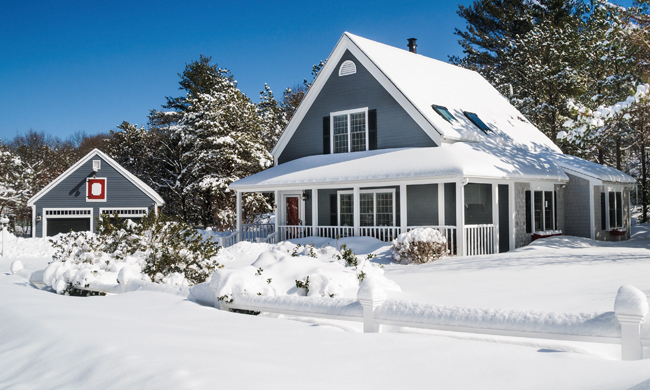7 Cost-Effective Ways to Reduce Heating Bills
02/13/2018 03:30AM ● By Family Features

Many homeowners think big when trying to find effective solutions to sky-rocketing heating bills, like replacing the furnace or installing new windows, but there are plenty of smaller projects that can make a difference when it comes to your energy savings this winter.
Consider these tips to keep your home cozy without your energy bill putting a damper on the season:

Take advantage of solar heat.
Installing solar panels is one sure way to capture the sun’s energy, but there are other ways to harness that heat. Unobscured windows and skylights can let the rays in, and with them comes some heat. Leave curtains open during the day and trim foliage outdoors to provide a clear path for sunlight. Just be sure windows are well-sealed so you’re not offsetting any heat gain with a cool draft.
Install or upgrade your heat pump.
Heat pumps work differently than traditional cooling and heating systems. They recycle heat found in the air and ground, moving thermal energy between indoors and outdoors instead of generating it from scratch by burning fossil fuels. When properly installed, an air-source heat pump can deliver one-and-one-half to three times more heat energy to a home than the electrical energy it consumes, according to the U.S. Department of Energy. They can save electricity costs by 30-40 percent.
In particularly cold climates, technology is making it possible to reap energy-saving benefits. An option such as the Hyper-Heating Inverter® from Mitsubishi Electric Cooling & Heating offers a significant advancement in heat pumps. This technology uses an intelligent compressor system to deliver heat even when outdoor temperatures are as low as -13 F, and a quick-start feature provides warm air instantly.
Move furniture away from vents.
Free air flow is an important component of efficient heating and obstructed vents interrupt that process. Not only can furniture be damaged from the continual air flow of a vent, it can block the circulation patterns that were intended when your home’s ductwork was installed. For optimum efficiency, avoid placing furniture on top of vents, and if it’s impossible to avoid, close those vents so the airflow is directed elsewhere.
Reverse your ceiling fans.
Your ceiling fans can play an important role in air circulation. Leaving them off will obviously make rooms warmer, but some circulation can be a good thing. Most fans offer a switch that lets you reverse the fan direction, which pushes air upward instead of down. This makes for less of a cooling effect while still moving air for better temperature distribution.
Install a programmable thermostat.
A degree or two may not feel like much of a difference, but it’s a change you’ll definitely see on your energy bill. Just a small adjustment in your standard thermostat setting can result in reductions of 5 or even 10 percent of your overall bill. Another potential big-impact strategy: adjust temperatures when you’re away from home. A programmable thermostat will let you turn temps down when no one is there to benefit from the warmth, then bring them back up shortly before you’re scheduled to return home. When you’re away unexpectedly or need to adjust your typical schedule, an option like the kumo cloud® mobile app offered by Mitsubishi Electric Cooling & Heating allows control of your home’s cooling and heating system from your smartphone or other connected device.
Adjust your hot water heater.
Not only can keeping the air comfortable add up, so can heating water for basic household functions. In fact, the U.S. Department of Energy estimates that water heating is the second largest energy expense in most homes. However, you may have your heater set higher than necessary. For every 10-degree drop, you can expect to reduce energy costs by 3-5 percent.
Insulate the attic.
A poorly sealed or insulated attic can be among a home’s largest energy drains. Warm air naturally rises, but rather than recirculating throughout the home, it may be wasted if it’s just escaping out of the attic. Sealing cracks and adding insulation can help reduce this loss. Don’t overlook the access door, which can allow warm air to escape if it fits poorly or isn’t well-sealed.
Busting Myths About Electric Heat Pumps
Like any technology, ductless heat pumps need to be used properly, and under the right conditions, in order to achieve maximum value. Learn how to get the most benefit from a ductless heat pump by debunking four of the biggest misconceptions about these devices.
- Myth: They are more expensive to run than oil or gas heaters.
- Fact: Multiple studies show that electric heat pumps save between $1,000-2,000 annually in energy costs, depending on the system’s efficiency, condition of the original equipment and climatic region.
- Myth: They collect and distribute bacteria.
- Fact: All split-ductless heat pumps have filters to gather and capture bacteria before it has a chance to grow. In fact, many indoor units include anti-allergy enzyme filters designed to reduce germs, bacteria and viruses in the space.
- Myth: They are only suitable for new construction.
- Fact: Ductless and hybrid (short duct run) heat pumps can provide superior efficiency levels and improved comfort in all homes, new and old.
- Myth: They don’t work in cold climates.
- Fact: Some systems, such as those offered by Mitsubishi Electric Cooling & Heating, offer a Hyper-Heat boost for especially cold climates. These systems deliver 100 percent heating capacity at 5° F outdoor ambient temperature and offer performance down to -13° F outdoor ambient temperature.
Find more options for managing your energy expenses this winter at mitsubishicomfort.com.







